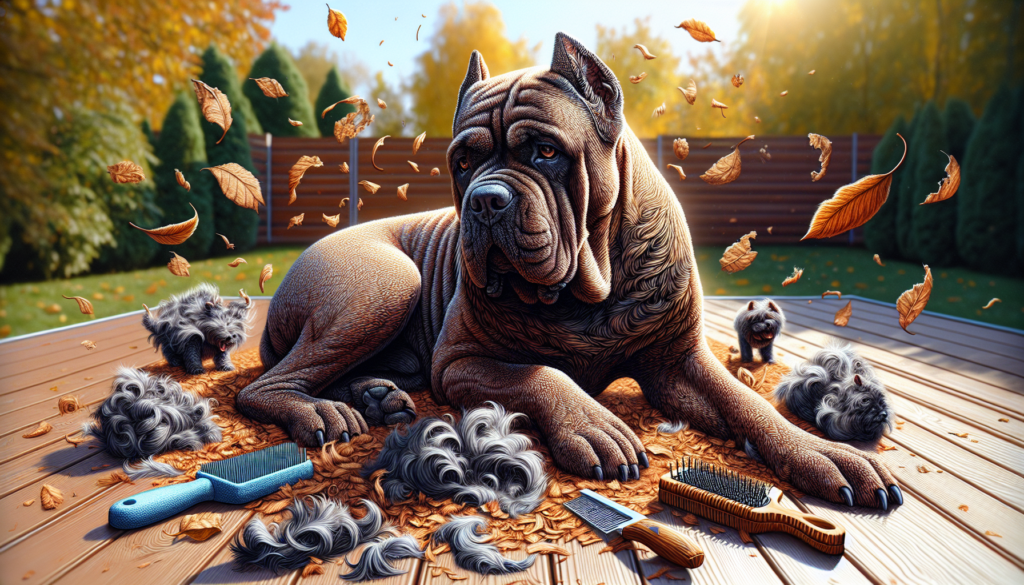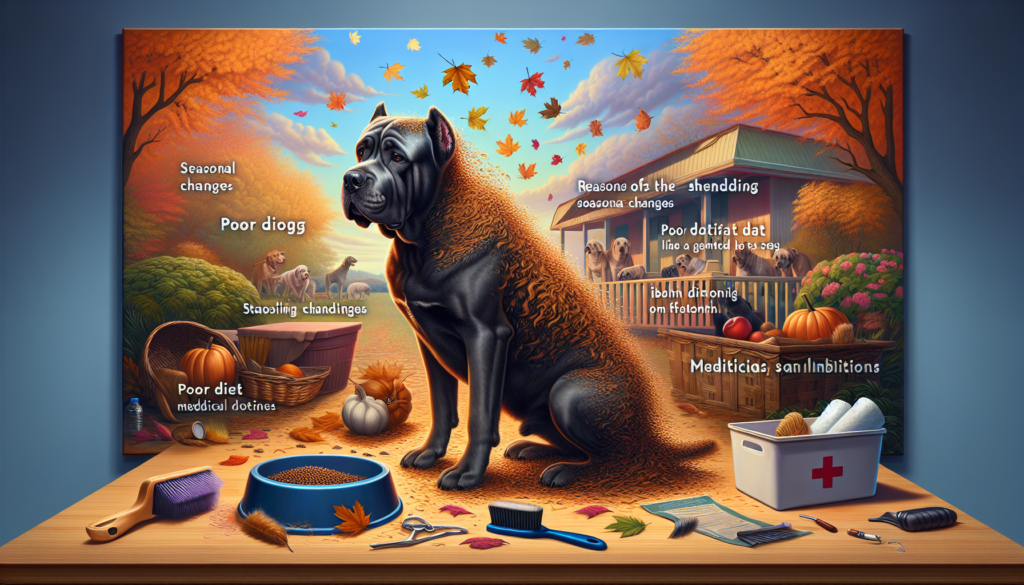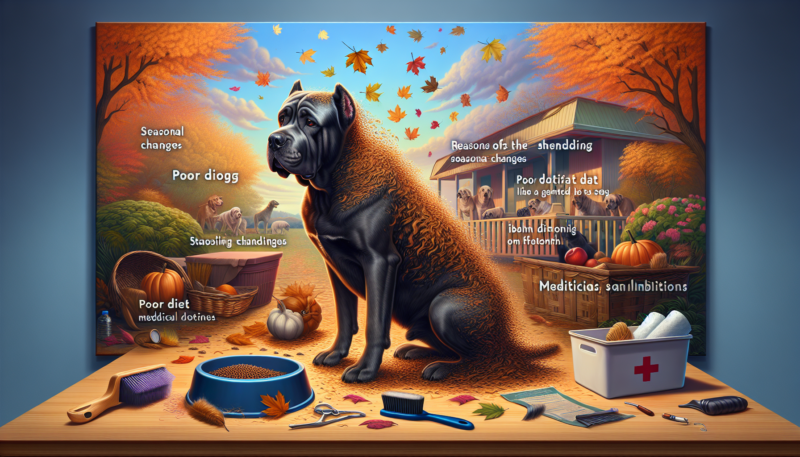Have you ever wondered why your beloved cane corso sheds so much? Excessive shedding can be a cause for concern and can leave you with fur-covered furniture and clothing. In this article, we will take a closer look at the reasons behind excessive shedding in cane corsos and provide you with some tips on how to manage and reduce this shedding. By understanding the underlying factors, you can help keep your cane corso’s coat healthy and your home fur-free.
Causes of Excessive Shedding
Natural Shedding Cycles
One of the most common causes of excessive shedding in dogs, including Cane Corsos, is their natural shedding cycles. Dogs naturally have shedding periods as a means of getting rid of old or damaged hair and making way for new growth. These cycles can vary in frequency, duration, and intensity depending on the individual dog. It is important to understand the natural shedding patterns of Cane Corsos to differentiate it from abnormal shedding.
Breed Characteristics
Breed characteristics can also contribute to excessive shedding in Cane Corsos. They have a double coat, consisting of a dense undercoat and a coarser outer coat, which provides insulation and protection. This double coat helps them adapt to different climates but can also lead to increased shedding. Additionally, Cane Corsos are considered a guard dog breed, which means they may have a higher tendency to shed compared to other breeds.
Stress and Anxiety
Stress and anxiety can have a significant impact on a dog’s overall health, including their coat condition. Just like humans, dogs can experience stress due to various factors such as changes in their environment, separation anxiety, or trauma. When a dog is stressed, it can disrupt their natural shedding cycles and cause excessive shedding. Identifying and alleviating stressors in your Cane Corso’s life can help minimize shedding.
Lack of Proper Nutrition
Proper nutrition plays a crucial role in maintaining a healthy coat for your Cane Corso. Dogs require a balanced diet that provides essential nutrients such as proteins, vitamins, and minerals to support coat health. If their diet lacks these nutrients, it can lead to poor coat quality and excessive shedding. Ensuring your Cane Corso is on a high-quality diet that meets their nutritional needs is essential for minimizing shedding.
Health Issues
Various health issues can contribute to excessive shedding in Cane Corsos. Allergies, skin infections, and hormonal imbalances are common culprits. Allergies can cause itchiness and inflammation, leading to excessive scratching and shedding. Skin infections, such as bacterial or fungal infections, can disrupt the normal hair growth cycle. Hormonal imbalances, such as an underactive thyroid, can also affect the coat and lead to excessive shedding.
Natural Shedding Cycles
Frequency of Shedding
Cane Corsos typically have two major shedding periods each year, commonly known as “blowing coat.” These shedding seasons occur in the spring and fall when they transition their coats to adapt to changing weather conditions. During these periods, you can expect a significant increase in shedding as they shed their old coat to make way for a new one. Regular grooming routines can help manage shedding during these times.
Seasonal Shedding
In addition to their shedding seasons, Cane Corsos may also experience minor shedding throughout the year. Changes in daylight, temperature, and humidity can trigger shedding even when it’s not their major shedding season. Regular brushing can help remove loose fur and minimize shedding in between the shedding seasons.
Shedding Patterns
Understanding the shedding patterns of your Cane Corso can help you differentiate between normal shedding and excessive shedding. It is normal for them to shed more on their body and tail compared to their head and legs. However, if you notice bald patches, excessive hair loss, or irregular shedding patterns, it may indicate an underlying issue that requires attention.

Breed Characteristics
Double Coat
Cane Corsos have a double coat, consisting of a soft, dense undercoat and a coarser outer coat. The purpose of this double coat is to provide insulation and protection from various weather conditions. However, the dense undercoat is what contributes to shedding in Cane Corsos. Regular grooming, including brushing, can help remove loose fur and minimize shedding.
Thick Undercoat
The thick undercoat of Cane Corsos is designed to keep them warm during colder months. However, this dense undercoat can become problematic when it starts shedding excessively. Regular brushing can help remove loose fur and prevent it from becoming matted or tangled.
Guard Dog Breed
As a guard dog breed, Cane Corsos naturally shed more compared to non-guard dog breeds. Their shedding helps them adapt to different environments and can act as a deterrent by leaving behind their scent. Regular grooming and proper coat care can help manage shedding in these breeds.
Stress and Anxiety
Effects on Shedding
Stress and anxiety can have a significant impact on a Cane Corso’s shedding patterns. When a dog is stressed or anxious, it can disrupt their normal shedding cycles and cause increased shedding. Additionally, stress can also lead to excessive scratching, which can further damage the coat and result in more shedding.
Common Stressors
There are several common stressors that can affect Cane Corsos and contribute to excessive shedding. These include changes in their environment such as moving to a new home, the introduction of a new pet or family member, separation anxiety, or traumatic experiences. Identifying and addressing these stressors can help minimize shedding caused by stress.
Reducing Stress
Reducing stress in your Cane Corso’s life is essential for maintaining their overall health and minimizing excessive shedding. Providing a stable and predictable environment, regular exercise, mental stimulation, and positive reinforcement training can all contribute to reducing stress levels. Additionally, you can also consider alternative therapies such as aromatherapy or calming supplements, under veterinary guidance, to help alleviate stress.

Lack of Proper Nutrition
Importance of Balanced Diet
Proper nutrition is vital for maintaining a healthy coat and minimizing excessive shedding in Cane Corsos. A balanced diet that provides all the necessary nutrients, including proteins, vitamins, and minerals, helps support healthy skin and coat. It is important to choose a high-quality dog food that meets the specific nutritional needs of your Cane Corso.
Lack of Essential Nutrients
When a dog’s diet lacks essential nutrients, it can negatively affect their coat health and contribute to excessive shedding. A deficiency in important nutrients such as Omega-3 fatty acids, B vitamins, and zinc can result in dry, brittle hair and an increased shedding rate. Consult with your veterinarian to ensure your Cane Corso’s diet meets their nutritional requirements.
Effects on Coat Health
A poor diet can impact the overall health of your Cane Corso’s coat, leading to increased shedding. Lack of essential nutrients can make the coat dry, dull, and prone to breakage. Ensuring your dog receives a well-balanced diet can help maintain a healthy coat and minimize shedding.
Health Issues
Allergies
Allergies can contribute to excessive shedding in Cane Corsos. Allergies can be caused by various factors such as food, environmental allergens like pollen or mold, or flea bites. When a dog is allergic to certain substances, it can cause itching, inflammation, and irritation, leading to excessive scratching and shedding. Identifying and managing allergies through allergen avoidance or veterinary-prescribed medications can help reduce shedding related to allergic reactions.
Skin Infections
Skin infections, such as bacterial or fungal infections, can also contribute to excessive shedding in Cane Corsos. These infections often cause itching, redness, and hair loss in affected areas. Treating the underlying infection with appropriate medications prescribed by a veterinarian is crucial to resolving the shedding issue.
Hormonal Imbalances
Hormonal imbalances, such as an underactive thyroid (hypothyroidism), can impact the coat health of your Cane Corso and result in excessive shedding. If the thyroid gland does not produce enough thyroid hormones, it can lead to dry, brittle hair and increased shedding. Veterinary evaluation and management of hormonal imbalances are necessary to address the shedding and promote coat health.
Managing Excessive Shedding
Regular Grooming
Regular grooming is essential for managing excessive shedding in Cane Corsos. Daily brushing helps remove loose fur and prevents it from accumulating in your home. Using appropriate grooming tools such as slicker brushes or deshedding tools can effectively remove loose hair from the coat. Additionally, frequent bathing with a mild dog shampoo can help keep the coat clean and healthy.
Proper Nutrition
Providing your Cane Corso with a well-balanced diet that meets their nutritional needs is crucial for managing excessive shedding. A diet rich in high-quality proteins, essential fatty acids, vitamins, and minerals promotes coat health and minimizes shedding. Consult with your veterinarian to determine the best diet for your Cane Corso’s specific needs.
Supplements and Additives
In some cases, supplements and additives can be beneficial in managing excessive shedding. Omega-3 fatty acids, such as fish oil, can help support coat health and reduce shedding. Additionally, certain supplements or additives containing biotin, zinc, or other essential nutrients can also contribute to a healthy coat. Always consult with your veterinarian before adding any supplements to your dog’s diet.
Medical Intervention
If excessive shedding persists despite proper grooming and nutrition, it may be necessary to seek medical intervention. A veterinarian can conduct a thorough examination and run diagnostic tests to identify any underlying health issues contributing to the excessive shedding. The appropriate treatment plan can then be implemented to address the specific condition and manage shedding effectively.
Grooming Techniques
Brushing
Regular brushing is integral to managing shedding in Cane Corsos. Brushing helps remove loose fur, prevent matting, and distribute natural oils throughout the coat. Use a slicker brush or a deshedding tool to thoroughly brush your Cane Corso’s coat, paying particular attention to the areas with thicker fur and undercoat.
Bathing
Frequent bathing with a mild dog shampoo can help keep your Cane Corso’s coat clean and healthy. Opt for dog-specific shampoos that are formulated to maintain the natural pH balance of their skin. Avoid over-bathing, as it can strip the coat of its natural oils and lead to dryness and increased shedding.
Desensitization
Some dogs may be sensitive or anxious during grooming sessions, which can exacerbate shedding. Desensitization techniques, such as gradual exposure to grooming tools and positive reinforcement training, can help your Cane Corso become more comfortable with grooming activities. Patience, consistency, and rewards can help create a positive association with grooming and reduce stress.
Professional Grooming
If you find it challenging to manage your Cane Corso’s shedding on your own, professional grooming services can be beneficial. Professional groomers have the expertise and proper tools to address shedding and maintain your dog’s coat health. Regular visits to a professional groomer can ensure your Cane Corso’s coat is well-maintained and shedding is minimized.
Choosing the Right Diet
High-Quality Dog Food
Choosing a high-quality dog food specifically formulated for your Cane Corso’s nutritional needs is crucial for maintaining a healthy coat and minimizing shedding. Look for dog foods that contain high-quality proteins, healthy fats, and a balance of essential vitamins and minerals. Avoid foods that contain excessive fillers or artificial additives, as these can contribute to poor coat health and shedding.
Omega-3 Fatty Acids
Omega-3 fatty acids, such as those found in fish oil, are beneficial for coat health and can help reduce shedding. These essential fatty acids contribute to a healthy skin barrier, reducing inflammation and improving the overall health of the coat. Consult with your veterinarian to determine the appropriate dosage of omega-3 fatty acids for your Cane Corso.
Protein and Vitamin-Rich Diet
Protein is an essential component of a healthy coat, as it provides the building blocks for hair growth and maintenance. Ensure your Cane Corso’s diet includes high-quality protein sources such as meat or fish. Additionally, a vitamin-rich diet containing essential vitamins such as vitamin A, B, E, and zinc can also promote coat health and minimize shedding.
Avoiding Common Allergens
If your Cane Corso is prone to allergies, it is important to identify and avoid common allergens in their diet. This may include ingredients such as grains, corn, soy, or certain proteins. Working closely with your veterinarian and conducting food trials can help identify any dietary triggers and reduce shedding related to allergies.
When to Seek Medical Help
Persistent Excessive Shedding
If your Cane Corso’s shedding remains excessive despite your efforts to manage it through grooming and proper nutrition, it is essential to seek veterinary assistance. Persistent excessive shedding may indicate an underlying health issue that requires medical intervention. Your veterinarian can conduct a thorough examination, run diagnostic tests, and develop a treatment plan to address the underlying cause of the excessive shedding.
Visible Signs of Skin Issues
If you notice any visible signs of skin issues, such as redness, sores, or bald patches, it is important to consult with a veterinarian. Skin issues can contribute to excessive shedding and may require medical treatment to resolve. Prompt veterinary attention can help prevent the issue from worsening and minimize the impact on your Cane Corso’s coat health.
Abnormal Behavior or Appetite Changes
Changes in behavior or appetite can sometimes be an indication of an underlying health issue causing excessive shedding. If you notice any abnormal behavior or significant changes in your Cane Corso’s appetite, it is important to seek veterinary advice. These symptoms, along with excessive shedding, may warrant further investigation to ensure your dog’s overall health and wellbeing.
Understanding the causes of excessive shedding in Cane Corsos is crucial for effectively managing and minimizing shedding. By addressing natural shedding cycles, considering breed characteristics, managing stress and anxiety, providing a balanced diet, and addressing any underlying health issues, you can help your Cane Corso maintain a healthy coat and reduce excessive shedding. Regular grooming, choosing the right diet, and seeking veterinary assistance when needed are all key components of keeping your Cane Corso’s shedding under control.
